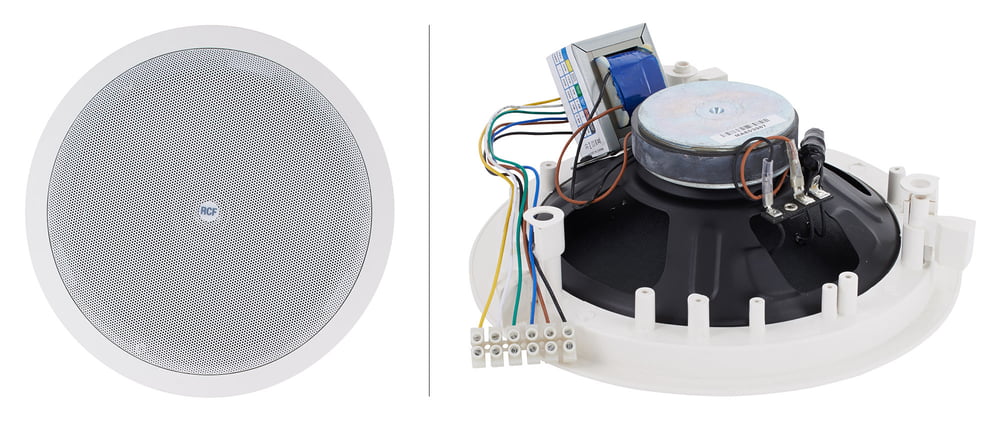3. Principles and general set-up
First we should say that voice or music playback usually happens in mono with 100V PA systems, since the distance between the speakers usually renders properly balanced stereo playback impossible. Furthermore, the listeners often move amongst the speakers, which also means that trying to achieve stereo playback is mostly pointless.
Should you be thinking about playing back music in two rooms simultaneously, you probably ought to opt for an amp that comes with an A/B switch for two separate speaker pairs. This would allow you to enjoy the music in stereo quality while at the same time sparing you the greater effort of installing a PA system.
Audio transmission makes use of the same principle of power transfer that is also applied in high-voltage lines:
Voltage is stepped up in order to render a large cable diameter unnecessary at the same output (not counting loss). At the end of the connection, the voltage is stepped down again to make it appropriate once more for devices and appliances.
With a PA system, something similar happens, with the difference that we're not talking about a supply voltage (sinus wave) here, but about an audio signal, and that we are, of course, transmitting much lower voltage. After all, the amplifier's maximum value at the output transformer is set at 100V, which is the reason we refer to it as 100V technology.
At the other end, this voltage is then reduced once more to a value that the speakers can use.

RCF PL 8X
This now allows you to put in longer cables with a lower diameter.
So this is the circuit diagram:

Principle of signal transmission
This is where it becomes clear that a HiFi listener would not profit from a 100V home PA system, even if modern transformers can easily deal with 50 20,000 Hz.
The additional feature offered by a 100V PA system is that it lends itself to announcements which interrupt the running programme and are intended to deliver information to listeners/customers.
The minimum setup of a 100V PA systems thus consists of a suitable amp, the appropriate number of speakers, at least one communication station and an audio source for the programme, e.g. a CD player.
Comparison to a low-Ohm system (HiFi or PA system)
Just to keep things clear once more:
When discussing 100V PA systems, we are talking about a decentralised sound system setup with a performance in the 100-200 W range. This is unlike HiFi or other PA systems.
With the latter, the main emphasis is delivering punchy and balanced sound to the audience.
Furthermore, the different systems are usually used in different types of spaces. A concert audience will see events in front of them, ranged over the stage from left to right. The sound is transmitted correspondingly. The audio representation of the stage show is a stereo event with a base (angle) of 180 degrees at most.
Cinema audiences are supposed to be integrated into the event acoustically. They are normally dispersed throughout the theatre, with a specific spatial relation to the sound source (front right, back middle, circle right, etc.) This situation is met by a 360-degree surround sound event.
100V PA systems offer neither option, and nor are they supposed to. 100V PA systems are all about transmitting information (as are telephones, which even have to work with seriously limited frequency ranges).
Music is no more than a background audio event, and may differ from room to room depending on the set-up of the system.
Is a 100V PA system right for you?
On summarizing the points addressed above, this is the conclusion:
You should consider investing in a 100V PA systems if you...
| 1. | ... want to use one or more rooms commercially and also want to offer your customers, guests, or participants background music evenly distributed throughout all spaces (supermarkets, hotels, restaurants, training facilities). |
| 2. | ... need to broadcast any kind of announcement in your rooms or open-air areas which cannot be broadcast through a central system (public pools, sports facilities). |
| 3. | ... are faced with adverse acoustic conditions which you can only satisfactorily deal with using many small individual speakers (churches, museums). |
| 4. | ... generally have to make safety and security announcements (office buildings, schools). |



